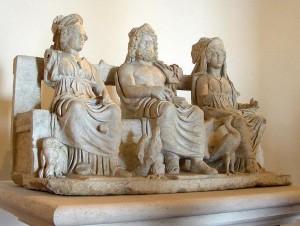The Roman festival year begins on the first day of March, the month which is dedicated to Mars. Appropriately our first festival of the year is dedicated to mothers and wives.
In ancient times, the calends of March celebrated the dedication of the Temple of Juno Lucina on the Esquiline Hill of Rome. She is the Goddess of Birth, the goddess who aids women during pregnancy and brings their child into the Light. Before Lucina’s temple stood a lotus tree, the second oldest tree in the City, which was sacred to Juno. The oldest lotus, called Capillaria, took its name from the Vestals who would hang their shorn hair on its limbs as an offering. Whenever a Roman child was born, by a royal decree of Rex Servius Tullius, the parents would make an offering to the Temple of Juno Lucina. Usually this was only a coin, and the child’s name would then be added to the records of all births to occur in the City. Juno Lucina was also called upon by newly wedded brides and by women who had not yet conceived a child.

Juno Capitolium was another goddess called upon by new brides and wives, for She is a goddess who protects the sanctity of marriage vows and marital relations. A story grew up that Juno, already angry over her husband’s affairs, became even more infuriated when She learned that Jupiter had given birth to a daughter. To relieve Jupiter’s headache, Vulcan split open His head with a mallet and out arose wise Minerva. Grey-eyed Minerva was addressed as “most chaste goddess” because Her conception and birth had not resulted from sexual intercourse. Juno was so angered by this that She decided that She, too, would bear a child on Her own, without any help from Jupiter. She enlisted the help of Flora, Goddess of Flowers, who provided Juno with a sacred lily that held pollen-laced dew. This was the semen that Flora poured from the lily into Juno’s ear. This immaculate conception of Juno is celebrated on 2 May as another sort of Matronalia comparable to modern Mother’s Day. Then, on the first day of the New Year, the first day of March, Juno gave birth to Mars.
Juno Lucina of the Esquiline is not the same goddess as Juno of the Capitoline Hill. They do, however, concern two aspects of being a wife and mother. There was a third element that brought their festivals together in a Matronalia. Romans usually waited to wed until the latter half of June, the month of Juno. Thus by 1 March a new bride would likely be in the tenth moon of her first pregnancy and expected to deliver any day. The Goddess of Marriage, the Goddess of Birthing, the birthday of Mars, and the New Year, all came together around a time when a family would celebrate the birth of their first child.

The custom therefore arose for husbands to shower their wives with gifts on Matronalia. Dainties and sweets, flowers and jewelry were given to celebrate a wife as mother to the family’s children. The children would join in with gifts of their own for their mother. And soon enough lovers began to give gifts on the first of the year as well. For modern cultores Deorum Matronalia thus becomes a sort of Valentine’s Day and Mother’s Day, as well as a celebration of wives. And we bear in mind, too, that as this is the first of the year, the harmony and joy of family felt this day is kept throughout the New Year. May you, too, have a happy, prosperous, and productive New Year.
Novum Annum: Bonum Felicem Faustumque sit!
















